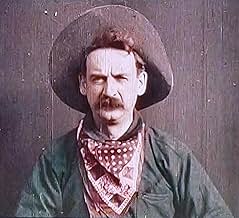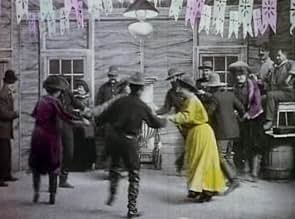PUNTUACIÓN EN IMDb
7,3/10
22 mil
TU PUNTUACIÓN
Añade un argumento en tu idiomaA group of bandits stage a brazen train hold-up, only to find a determined posse hot on their heels.A group of bandits stage a brazen train hold-up, only to find a determined posse hot on their heels.A group of bandits stage a brazen train hold-up, only to find a determined posse hot on their heels.
- Premios
- 1 premio en total
Gilbert M. 'Broncho Billy' Anderson
- Bandit
- (sin acreditar)
- …
A.C. Abadie
- Sheriff
- (sin acreditar)
Justus D. Barnes
- Bandit Who Fires at Camera
- (sin acreditar)
Walter Cameron
- Sheriff
- (sin acreditar)
John Manus Dougherty Sr.
- Fourth Bandit
- (sin acreditar)
Donald Gallaher
- Little Boy
- (sin acreditar)
Shadrack E. Graham
- Child
- (sin acreditar)
Frank Hanaway
- Bandit
- (sin acreditar)
Adam Charles Hayman
- Bandit
- (sin acreditar)
Robert Milasch
- Trainman
- (sin acreditar)
- …
Marie Murray
- Dance-Hall Dancer
- (sin acreditar)
Frederick T. Scott
- Man
- (sin acreditar)
Mary Snow
- Little Girl
- (sin acreditar)
Argumento
¿Sabías que...?
- CuriosidadesThe original camera negative still exists in excellent condition. The Library of Congress, who holds it, can still make new prints.
- PifiasWhen the telegraph operator revives with his hands tied behind his back, he uses one of his hands to help him stand up and then quickly puts the hand behind his back again.
- Versiones alternativasThere is an Italian edition of this film on DVD, distributed by DNA srl, "CENTRO! (Straight Shooting, 1917) + IL CAVALLO D'ACCIAIO (The Iron Horse, 1924) + LA GRANDE RAPINA AL TRENO (The Great Train Robbery, 1903)" (3 Films on a single DVD), re-edited with the contribution of film historian Riccardo Cusin. This version is also available for streaming on some platforms.
- ConexionesEdited into Hollywood: The Dream Factory (1972)
Reseña destacada
What can one say about an 11 minute film, which is reputed to be the first narrative motion picture to be shot in the United States? What does one compare it to when nothing had come before it? What is even more amazing is that parts of this movie are in color! The women's dresses at the dance are in color - each frame had been hand colored. The flashes from the barrels of the six shooters are red and an explosion sends up a riot of color. There is even a little girl in a red coat. Take that, Steven Spielberg!! Except for the last five seconds, all of the shots are in medium to long. The camera never moves. For each sequence, it is set in place and actors move in front of it.
It is a western, of course (shot in the wilds of New Jersey). A gang of bad guys knock out a train station clerk then board a departing train. They move to the car where there is a safe, blow the safe, stop the train and rob the passengers. Back in town, the clerk revives and tries to get help but passes out again. A little girl comes in wakes him up. The townspeople are having a dance when the clerk runs in to form a posse. The posse rides out and surrounds the gang, who is counting the loot in the woods. There is a gunfight and the robbers are killed. That is the whole story, but there is one short scene left - one of the most remarkable in film history. The all color episode lasts about 5 seconds. In medium close-up, a cowboy raises his pistol, points it directly at the camera, and fires three times. It is difficult for us to understand why this is here or what purpose it served. But when people who had never seen a movie before and didn't have any understanding of the technology first saw this man shooting at them, they screamed, fell to the floor, and ran for the door. It is also said that some in the audience pulled firearms and shot back. It is an early testament to the power that motion pictures had, even in its earliest incarnation. Thankfully, TCM ran TGTR without any modern musical accompaniment, as thousands must have seen it in the nineteen-aughts. I watched in total amazement. I was transported. Later, I reflected on how far movies had come and how little they had changed in the last 100 years. This movie is a priceless historical artifact that shows us just how much the past is still with us.
It is a western, of course (shot in the wilds of New Jersey). A gang of bad guys knock out a train station clerk then board a departing train. They move to the car where there is a safe, blow the safe, stop the train and rob the passengers. Back in town, the clerk revives and tries to get help but passes out again. A little girl comes in wakes him up. The townspeople are having a dance when the clerk runs in to form a posse. The posse rides out and surrounds the gang, who is counting the loot in the woods. There is a gunfight and the robbers are killed. That is the whole story, but there is one short scene left - one of the most remarkable in film history. The all color episode lasts about 5 seconds. In medium close-up, a cowboy raises his pistol, points it directly at the camera, and fires three times. It is difficult for us to understand why this is here or what purpose it served. But when people who had never seen a movie before and didn't have any understanding of the technology first saw this man shooting at them, they screamed, fell to the floor, and ran for the door. It is also said that some in the audience pulled firearms and shot back. It is an early testament to the power that motion pictures had, even in its earliest incarnation. Thankfully, TCM ran TGTR without any modern musical accompaniment, as thousands must have seen it in the nineteen-aughts. I watched in total amazement. I was transported. Later, I reflected on how far movies had come and how little they had changed in the last 100 years. This movie is a priceless historical artifact that shows us just how much the past is still with us.
- MikeF-6
- 5 mar 2003
- Enlace permanente
Selecciones populares
Inicia sesión para calificar y añadir a tu lista para recibir recomendaciones personalizadas
Detalles
Taquilla
- Presupuesto
- 150 US$ (estimación)
- Duración11 minutos
- Mezcla de sonido
- Relación de aspecto
- 1.33 : 1
Contribuir a esta página
Sugerir un cambio o añadir el contenido que falta

Principal laguna de datos
By what name was Asalto y robo al tren (1903) officially released in India in English?
Responde











